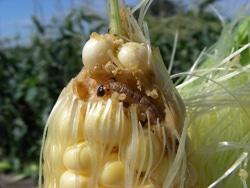Study of 40 years of data shows how GMO crop led to significant reductions in corn borer population and pesticide spraying.
March 13, 2018

University of Maryland researchers have pulled together 40 years of data to quantify the effects of Bt corn, a highly marketed and successful variety of genetically modified corn, in a novel and large-scale study.
According to the university, other studies have demonstrated the pest management benefits of Bt corn adoption for pests like the corn borer in corn itself, but this is the first study to look at the effects on other off-site crops in North America.
By gaining control of the corn borer population, this study shows significant decreases in recommended spraying regimens, pest populations and overall crop damage not just for corn but also for peppers, green beans and other important crops to North American agriculture, the announcement said. These benefits have never been documented before and showcase Bt corn as a powerful tool to combat pesticide resistance and advance the agriculture industry.
Bt corn is a genetically modified organism (GMO) first introduced and adopted in the U.S. in 1996 that now makes up more than 90% of the current U.S. corn population.
In this study, Dr. Galen Dively, University of Maryland professor emeritus and integrated pest management consultant in the department of entomology, and research associate Dr. Dilip Venugopal used data from 1976 to 2016 to look at trends 20 years before and 20 years after the adoption of Bt corn.
“Safety of Bt corn and other GMOs has been tested and proven extensively, but this study is about effectiveness of Bt corn as a pest management strategy, particularly for off-site crops or different crops in different areas than the Bt corn itself,” Venugopal explained.
“This is the first paper published in North America showing off-site benefits to other host plants for a pest like the corn borer, which is a significant pest for many other crops like green beans and peppers,” Dively said. “We are seeing really more than 90% suppression of the corn borer population in our area for any crop, which is incredible.”
Using numbers from pest traps to estimate the population and examine the recommended spraying regimens for pests like the corn borer, Dively and Venugopal observed significant reductions in the population, with much less spraying occurring over time.
“There would be no recommendation to spray for the corn borer given the current population, and this paper can trace that back to Bt corn adoption,” Dively explained. “What’s more, by looking at the actual pest infestations and damage on actual crops over 40 years of data, we took it a step farther to see the benefits on all sorts of crops and the declines in the actual pest population. We are able to see the results in theory and in practice on actual crops and in the real pest population over a long stretch of time.”
“The next steps would to be quantify the millions and millions of dollars in economic benefits we see here in a very concrete way to show money and time saved on spraying and pest management, crop damage reduction, as well as consideration of the environmental benefits,” Venugopal added. "The important thing here, however, is to think of Bt corn as one of many tools in an integrated pest management tool box. The benefits are undeniable but must always be weighed against many other options to use a broad range of tools and maximize benefit while minimizing any potential risks."
Dively concluded, “This study ultimately shows the importance of evaluating GMO crops beyond the field that is being planted. These products and the new advances coming down the pike have the potential to suppress major pest populations just like Bt corn has. This is just the beginning, and we need to be quantifying these effects. I am excited by these results and encouraged for future work.”
Their paper was published in Proceedings of the National Academy of Sciences.
You May Also Like


.png?width=300&auto=webp&quality=80&disable=upscale)
